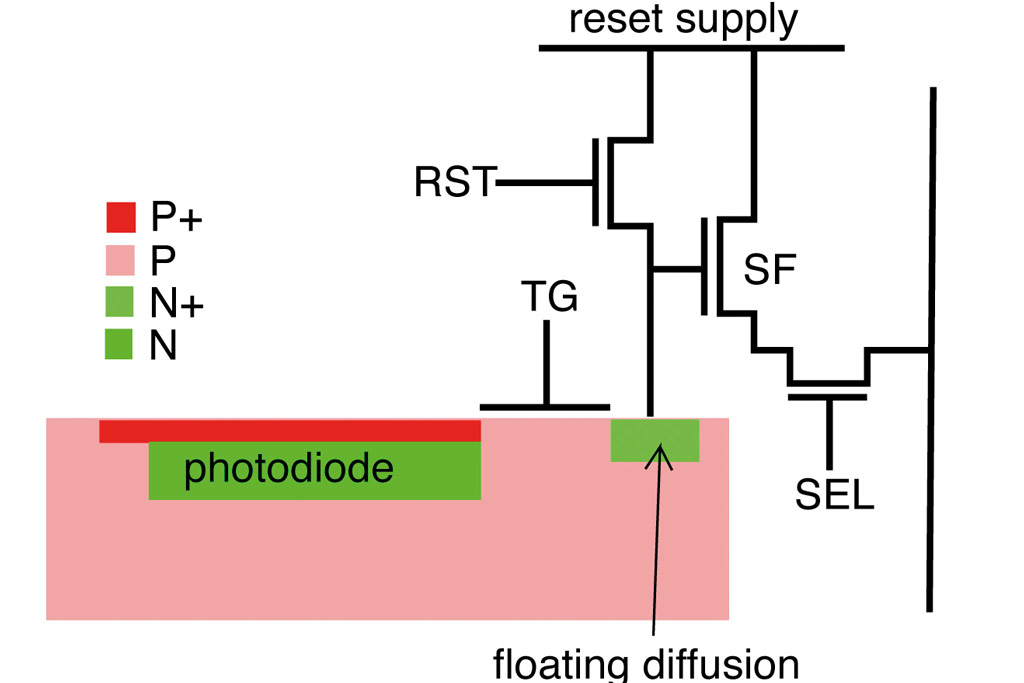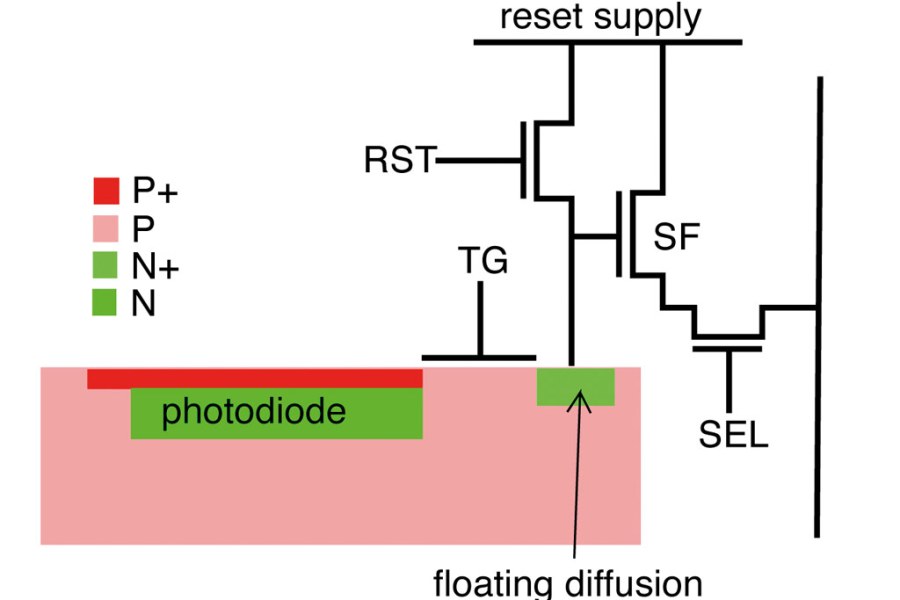The task assigned to me for this article was to explain how the ‘Live ND Filter’ function found in Olympus/OM System cameras works. The feature originally arose in some Sony cinema cameras, but OM is the only company currently offering it in still cameras. It allows long exposure times without increased exposure, allowing creative use of slow shutter speeds in low light, in just the same way as a real neutral density filter would. Information on how it actually works is sparse, so my first attempt was to try to understand how a sensor image acquisition cycle could be used to provide this functionality.
Let’s first go through how this cycle works. The diagram shows the structure of a conventional CMOS pixel. The red/pink/green structure on the right shows the structure of the photoactive part, which is sometimes called the ‘photodiode’ or ‘photoreceptor’ (both descriptions are slightly inaccurate, but commonly used). The electronic functions, comprising four transistors, are shown diagrammatically. The transistors are labelled as follows: ‘TG’, the transfer gate; ‘RST’, the reset gate; ‘SF’, the source follower amplifier; and ‘SEL’, the selection gate. Their functions will be explained as we proceed.
The photoactive part of the sensor consists of four different regions constructed from different types of silicon. The silicon is modified or ‘doped’ by implanting atoms of other elements causing a surplus or deficit of electrons. Silicon with a surplus of electrons is called ‘N-type’ and is shown in green. That with a deficit is called ‘P-type’ and is shown in red. When there is a junction between a P and N area a ‘depletion region’ arises, which is starved of current carriers and across which current cannot flow. If the P region is at a sufficient potential to draw electrons into the depletion region then current can flow. Thus this structure forms a diode, allowing current flow in one direction. The large photoreceptor (N) is completely surrounded by P silicon, meaning that it retains any photoelectrons that are generated by incoming light.

The standard four-transistor CMOS pixel design. How could it be manipulated to provide a Live ND function?
Live ND filter – How the sensor works
The CMOS sensor cycle works as follows. First the reset and transfer gates are opened to connect the reset supply to the floating diffusion and in turn to the photodiode, which is thereby reset to a (relatively) high voltage. Once the transfer gate is closed exposure starts, and photoelectrons accumulate, causing the voltage to drop. At the end of the exposure the transfer gate is opened again and the photoelectrons flow to the floating diffusion, now disconnected from the reset supply. The source follower reads the resultant voltage level and transfers it to the column line when the selection gate is opened to allow a line of pixels access.
So, how might this sensor cycle be adapted to provide a Live ND function? The only way I could think of is to leave the floating diffusion connected to the reset supply during the exposure and modulate the transfer gate, causing a partial reset as the exposure proceeds. At the end of the exposure the floating diffusion would be disconnected, allowing the pixel to be read out as normal. In principle it would work, but it would require very accurate and predictable control of the modulation to avoid serious image degradation.
As it happens, the actuality of how Live ND works is much simpler. The sensors used are capable of 60 frames-per-second readout, so the Live ND, which only operates for shutter speeds slower than 1/30th second, simply takes multiple short exposures and composes them in the image processor. The amount of ND depends on the relationship between the length of the short exposures and 1/60th second. So, for instance, if 1/120th second exposures are used, it will produce the effect of a 50% ND filter.
Bob Newman is currently Professor of Computer Science at the University of Wolverhampton. He has been working with the design and development of high-technology equipment for 35 years and two of his products have won innovation awards. Bob is also a camera nut and a keen amateur photographer
Further reading:
Follow AP on Facebook, Twitter, Instagram, YouTube and TikTok.









